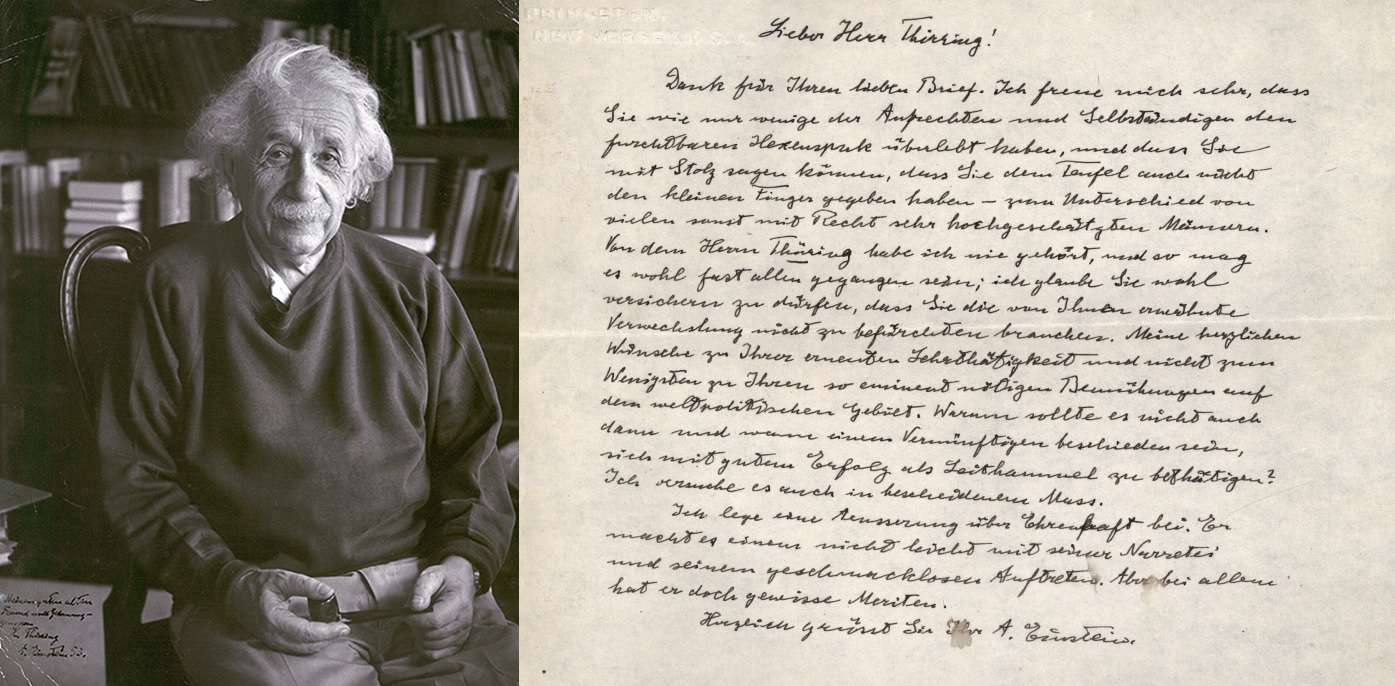


Although Albert Einstein never lived or worked in today’s Austria, his relations with this country were close, in particular because Einstein had long-standing friendships with Austrian scientists and intellectuals.
This goes back to Einstein's student years, when Friedrich Adler, the son of the founder of the Austrian Social Democratic Workers’ Party, became one of his best friends. Einstein and Adler trained together as subject teachers for mathematics and physics in those days. Later Adler renounced a professorship in Zurich in favor of Einstein and returned to Vienna. In 1916, he shot the Austrian Prime Minister Karl Graf von Stürgkh in a protest against the government's war policy.
Ironically, it was also Stürghk in his capacity as a minister of education who had conducted appointment negotiations with Einstein a few years earlier. These led to Einstein becoming a professor at the German University in Prague (1911), then part of theAustro-Hungarian Empire. To take up this post, Einstein was asked to become a citizen of the Habsburg Monarchy and bought himself a splendid Austrian civil servants uniform. However, he wore it only once (when he was sworn into office) and sold it to his successor at half price when returning to Zurich not even two years later.
Einstein's visits to Austria were not very frequent. Nevertheless, the lectures he gave in this country reflect his growing reputation and fame even beyond scientific circles. In 1909, at the annual conference of natural scientists in Salzburg, Einstein spoke for the first time to a larger audience on the theory of relativity. Einstein’s ideas triggered heated discussions among the experts but general public took little notice of the event.
Things were quite different when Einstein came to visit Vienna twelve years later. Due to the great public interest, Einstein's popular science lecture (“Relativitätstheorie leicht fasslich”) was moved from the Urania to the Konzerthaus, the largest auditorium in Vienna at the time. There the atmosphere was excited and noisy with 3,000 people eager to see the genius in person. Einstein said later that the audience was in a strange mood “where it doesn’t matter at all what you understand, but only that you are in the immediate vicinity of a place where miracles happen.” The Austrian press, down to the smallest regional papers, reported the event. However, Einstein also spoke to a professional audience during these days, namely at the Chemical-Physical Society of the University of Vienna. Even there public attendance was enormous, as the records of the society, now kept in the archives of the Central Library of Physics, show.
When Einstein was in Vienna, he stayed at 70 Grinzinger Straße with Felix Ehrenhaft and his wife Olga, who was one of the first female university-trained physicists in Austria. Ehrenhaft –the enfant terrible of Viennese physics– was a gifted experimenter but a headstrong person. "He doesn't make it one easy with his foolishness and tasteless manner. But for all that, he has certain merits" Einstein wrote about his friend. (More on the shifting relationship between Einstein and Ehrenhaft can be found in the blog post by Gildo Magalhães dos Santos: https://www.iqoqi-vienna.at/blogs/blog/felix-ehrenhaft-a-disonant-voice-from-vienna-or-the-cost-of-being-against-paradigms).
Besides Adler and Ehrenhaft, Einstein had close ties with many other Austrians such as Sigmund Freud, Paul Ehrenfest, Wolfgang Pauli and Lise Meitner. Important catalysts for Einstein‘s thinking from the very beginning were Ludwig Boltzmann and Ernst Mach. Einstein und Erwin Schrödinger started to correspond about de Broglie’s matter waves in 1925 and regularly exchanged letters until Einstein died in 1955. Marietta Blau, who had carried out groundbreaking work on photographic particle detection in Vienna, was recommended by Einstein for a post in Mexico when she had to flee Austria because of the Nazi takeover.
An important Austrian associate of Einstein was the topologist Walther Mayer from Graz. Mayer followed Einstein into exile to Princeton where he was known as "Einstein's calculator". Also in Princeton, Einstein had a congenial interlocutor, the Viennese Kurt Gödel, according to Einstein, "the greatest logician since Aristotle".
Einstein also had a long-standing friendship with the Viennese theoretical physicist Hans Thirring (see the blog post by Herbert Pietschmann: www.iqoqi-vienna.at/blogs/blog/hans-thirring-a-personal-recollection), one of the first proponents of the theory of general relativity. Inspired by Einstein, Thirring postulated the so-called frame dragging effect (or Lense-Thirring effect). Einstein held Thirring in high esteem because he took a clear stance against National Socialism and militarism. After 1945, Thirring became a warner against nuclear war and a proponent for disarmament and peace, which pleased Einstein. Battered by the horrors of the 20th century, but still optimistic, Einstein wrote to Thirring in 1946 “Why shouldn't a sensible person be a political bellwether (“Leithammel”) for once?”
References and further reading
Broda, Engelbert: Der Einfluß von Ernst Mach und Ludwig Boltzmann auf Albert Einstein. In: Treder, H.J. (Ed.): Einstein-Centenarium, Berlin, 1979, p. 227-237.
Broda, Engelbert: Einstein und Österreich. Wien, [1973]. (Veröffentlichungen der Kommission für die Geschichte der Mathematik, Naturwissenschaften und Medizin, Verlag der Österreichischen Akademie der Wissenschaften, Heft 33).
Fölsing, Albrecht: Albert Einstein. Eine Biographie. Frankfurt am Main, 1993.
Frank, Philipp: Einstein. - His life and times. London, 1948.
Gordin, Michael D.: Einstein in Bohemia. Princeton and Oxford, 2020.
Grieser, Dietmar: Per Adresse Ehrenhaft. In: Grieser, Dietmar: Alte Häuser – Große Namen. Ein Wien-Buch. St. Pölten and Wien 1986, p. 145-148.
Hofmann, Thomas: Relativitätstheorie ‚leicht fasslich‘. In: Wiener Zeitung 24./25.10.2015, p. 35.
Kirchgatterer, Brigitte: „Das ist das Genie“ In: Kurier, 21.9.2009, p. 16
Laue, Max von, "Einstein, Albert". In: Neue Deutsche Biographie 4(1959), p. 404-408 [Online-Version]; URL: https://www.deutsche-biographie.de/pnd118529579.html#ndbcontent; last accessed 2021-11-10
Reiter, Wolfgang L.: „Mein weiland Vaterland Österreich“. In: Heureka. Das Wissenschaftsmagazin im Falter, Nr. 1, 2005; URL: https://www.falter.at/heureka/20050126/mein-weiland-vaterland-oesterreich/1625500079; last accessed 2021-11-10
Santos, Gildo M.: "A debate on magnetic current. – The troubled Einstein–Ehrenhaft correspondence. In: British Journal for the History of Science 44(2011), p. 371–400.